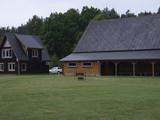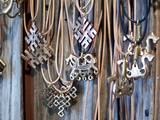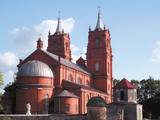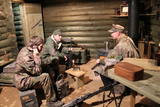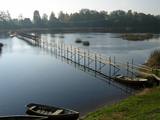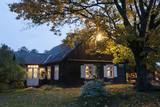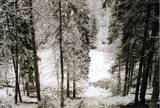| Nr | Name | Beschreibung |
|---|---|---|
|
The tower is at the western end of the Seda swamp, accessed from the side of Jērcēni. Transport is limited here. The tower is in the area of the swamp where peat moss is extracted. It offers a broad view of the ponds of Seda and a boat rental facility that is nearby. It is an appropriate location for bird-watching during the season of migration. There is another bird-watching platform near the town of Seda. This is part of the ZBR. |
||
|
"Valgums" is a word referring to the sandy coastline zone between dunes and water, and once there were boats and nets that were being dried at this location. Each village had several areas of this type, and in the 1920s and 1930s, these were of great importance in the preservation of the Liv language. |
||
|
Just 20km from Valmiera down the river Gauja in Gauja National park theritory we own fabilous place for lovers of leisurely holidays with good active tourism possibilities. Main building with kitchen, shower, WC and higher standard accomodation possibilities. Big shelter with lodges next to it. Big area with fireplace. Sleeping facilities in 2 nd floor and some extra sleeping facilities and big shelter in separate building. There are You can find marked bicycle trail Valmiera-Cēsis next to the CAMP CAUNĪTES. Guests can use canoes for fishing or short tours along the river Gauja. |
||
|
In diesem Park kann man die von dem Besitzer gefertigten Einbäume, das Modell des Schlosses von Nurmiža und andere Gebäudemodelle, sowie ein Haus aus Sand besichtigen. Hier kann man an verschiedenen thematischen Veranstaltungen teilnehmen. Männer können hier Rinnen für die Gewinnung von Birkensäften fertigen, aber Frauen – Schmuckstücke aus Naturmaterialien basteln. Einbaum-Erzeugnisse wurden von den Menschen schon im Mesolithikum hergestellt, aber Einbäume (im Park sind mehrere davon) wurden mehr ab dem 9. Jh. benutzt. |
||
|
The craftsman uses experimental archaeological methods to produce the jewellery of ancient Baltic tribes. He will tell you about their symbolism, meaning and wearing traditions. You can tour the workshop and purchase jewellery that has been made there. |
||
|
Das Café befindet sich im Zentrum von Ludza. Hier kann man Gerichte aus einer vielfältigen Speisekarte und auch Tagesangebote wählen. Ein besonderes Angebot des Kochs sind Süßwasserische aus den Seen der Region Latgale. Lettische Küche: Speisen, bei deren Vorbereitung Hechte, Schleien, Karpfen und Zander verwendet werden. Während der Wintersonnenwende werden auf Bestellung Blutwürste, Bratwürste und Schweinerüssel vorbereitet. Das besondere Gericht: Fischkäse: kalte Vorspeise aus gemahlenem Fisch mit Zutaten. |
||
|
Immaculate Conception of Virgin Mary Roman Catholic Church of Nautrēni (Rogovka). The construction
works of the brick church lasted from 1901 till 1914. It is an example of Romantesque style. The
organ was bought in 1939; it is a national cultural monument.
|
||
|
Diese Route ist mit sehr ungewöhnlichen Aussichten! Seda ist die einzige Stadt in Lettland, in der sich noch aus der Sowjetzeit aus der Mitte des vorigen Jahrhunderts die Planung mit dem Zentralpatz und Straßen erhalten hat, die strahlenförmig zu dem Zentralplatz führen. Ein wenig exotisch ist der Baustil der Wohnhäuser und der öffentlichen Gebäude. Das Moor von Seda, wo Torf schon während der ersten Unabhängigkeit Lettlands gewonnen wurde, ist eines der größten industriellen Naturgebiete dieser Art in Lettland und in den baltischen Ländern. Die früher bearbeiteten Torfgelände sind zum Teil überschwemmt und mit Schilfrohr zugewachsen, das bildet eine ausgezeichnete Umgebung für nistende Wasservögel und Zugvögel, die das Moor von Seda zur Erholung benutzen. Der Torf wird auch heute gewonnen und vielleicht hat man Glück und man kann den kleinen Torfzug sehen. Route information from Latvijas Lauku forums |
||
|
Pie Vidzemes šosejas pirms Melturu tilta pāri Amatai ir privātais muzejs "Mežabrāļu bunkurs". Bunkurs izveidots, lai varētu vēstīt par Nacionālo partizānu mežabrāļu cīņu laikā no 1944.-1956. gadam, kad mežos pret okupācijas varu cīnījās ap 20 000 Latvijas patriotu. Nacionālo partizānu bunkurs izveidots balstoties uz savāktajām mežabrāļu atmiņām, dienasgrāmatu pierakstiem un fotogrāfijām. Uz bunkuru ved meža taka ar informāciju par dažādiem mežabrāļu piedzīvojumiem un cīņām. Bunkura pazemes daļā apskatāmi vēsturiskie priekšmeti, kas viņus pavadīja dzīvē un cīņā. Saimnieks piedāvā pastaigu pa meža taku, kur izvietota informācija par mežabrāļiem un slēpņu spēle bērniem. Ar iepriekšēju pieteikšanos iespējams iekļūt bunkurā un apskatīt iekārtotu bunkuru ar mežabrāļu izmantoto ieroču, munīcijas un citu priekšmetu ekspozīciju. Stāstījumu papildina savāktās mežabrāļu interviju videoieraksti. Apmeklētājiem iespējams pasūtīt mednieku desiņu cepšanu lapenē pie bunkura. |
||
|
Находятся в 100 м к юго-востоку от Приекульского замка. Символ Приекуле, изображенный на гербе города. Ворота (1688 г., отреставрированы в 1954 г.) служили в качестве сторожевой башни сквозных ворот Приекульской господской усадьбы, где проводился досмотр торговцев (таможня), отправляющихся или приезжающих из Литвы. Интерес представляет родовой герб баронов Корфов выполненный в XVIII веке из голландского песчаника, с серебряным ядром и своеобразный маскарон в центральной части фасада. Во времена баронов в нишах по обеим сторонам стояли двухметровые, выполненные в камне, грозного вида фигуры стражников - солдат. Сегодня на их месте стоят деревянные фигуры стражников. |
||
|
Where the little Rumbiņa river flows into the Daugava (on the left bank of the little river opposite the Lielvārde park), there is the Dievkalns castle hill that has been reduced by the waters of the Daugava. It is also known as the Cepure hill. According to antiquities that have been found here, representatives of Baltic tribes lived here from the first millennium BC to the 6th or 7th century AD. The level of the Ķegums hydroelectric power plant can be reached by a staircase from which the best view of this object can be found.
|
||
|
Die Flüsse Salaca und Svētupe sind zu den einzigen Orten auf der Welt ernannt, wo man beim industriellen Fischfang der Neunaugen immer noch eine mehr als 150 Jahre alte Methode benutzt: den Fischzaun (einen über den Fluss gebauten Steg mit Fischreusen, insgesamt drei Fischzäune). Unter der Leitung der örtlichen Fischer kann man die Fischzäune besichtigen, den Fischfang beobachten und Vorort gegrillte Neunaugen probieren. |
||
|
A small food producer in Vidzeme, which is engaged in the processing of vegetables, fruits and berries, producing healthy snacks without sugar and flour. Offers tasting tours, master classes on vegetable truffles and healthy cakes, actively involving guests. Soon there will be a lunch offer - a special kale cabbage soup. |
||
|
Stūrīši is a homestead owned by the Taisel family, offering a collection and a chance to taste Liv foods: fish soup, porridge, sprat sandwiches, pastries, etc. |
||
|
Familienbetrieb Hiiu Vill ist einer der wenigsten Wollebearbeitung-Unternehmen in Estland, wo zum Bearbeiten der Schafwolle die polnische Maschienen (Krempelwolf, Spinnmaschiene etc.) aus der 19. Jh. benutzt wird. Gäste sind hier herzlich willkommen. Im Sommer gibt es draussen ein Cafe und ganzjährig besteht die Möglichkeit Wollesachen einzukaufen. |
||
|
Ein mit Wäldern und Seen reiches Gebiet im Nordteil der Dzūkija-Anhöhe. Das Täufelsbeet (Velnio duobė) ist eine bis 40 m tiefe und 200 m breite trichterförmige Grube, die Entstehung der mit einer Tätigkeit eines urzeitlichen Gletschers verbunden ist. |
||
|
Wenn man auf der Straße Nereta – Ilūkste fährt, kann man das Gotteshaus schon von weitem sehen. Es ist im Jahr 1805 gebaut, aber im Jahr 1888 restauriert worden. In der Kirche haben sich der ursprüngliche Altar, die Kanzel und der Orgelprospekt erhalten. An der Kirche sind die im Ersten Weltkrieg gefallenen deutschen Soldaten bestattet worden. An der westlichen Gebäudewand befinden sich zwei Gedenktafeln, die zu Ehren der im Ersten Weltkrieg gefallenen Einwohner der Gemeinde Laši und der während der Sowjetzeit Repressierten enthüllt sind. |
||
|
Находится в 50 м к западу от Лудзенской католической церкви. Построена в 1738 году в форме восьмиугольной ротонды и служила местом отдыха графов Карницких. Небольшое здание с дощатой обшивкой, деревянным потолком и кирпичным полом. Возле капеллы установлена скульптура Девы Марии (1934 г.) работы лудзенского художника Леона Томашицкого - королевы земли Мары. |
||
|
Целостное здание церкви строилось в 1780 – 1781 гг. во времена барона Х.Ф. Бера, а перестраивалось в 1876 и 1888 гг. Церковь известна своим алтарем и кафедрой, выполненными в стиле рококо, и построенным в первой половине XVIII века органом. Церковь можно осмотреть изнутри. |
||
|
Das Landgutsensemble in Milzkalne am Ufer des Flüsschens Slocene begann sich im 15. Jahrhundert zu bilden als einen geschlossenen Komplex fränkischen Typs für die Wirtschaftsbedürfnisse des Ordens und ist heutzutage ein einzelnes erhaltenes Beispiel eines befestigten Landguts solchen Typs (als ein Versteck für Gutsbesitzer im Angriffsfall) in Lettland. Am Ende des 17. Jahrhunderts wurden Tortürme mit den herrschaftlichen Flügeln, aber in den 18 – 19 Jahrhunderten – auch die Wirtschaftsgebäude errichtet. Von der ursprünglichen Bebauung ist eine Mauer mit den Schießöffnungen erhalten geblieben. In einem der Flügel des Komplexes wurde das Straßenbaumuseum Lettlands eingerichtet. In einem Hauptgebäude des Landguts befindet sich ein Hotel, hier werden Exkursionen und Verkostungen von Landerzeugnissen angeboten. |
||


